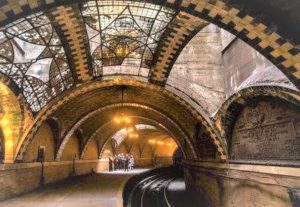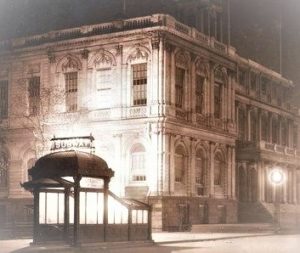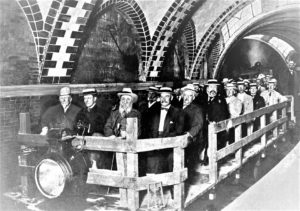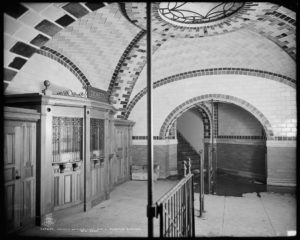Concetta Anne Bencivenga (Thailand), Director of the Transit Museum of New York Subway
Concetta Anne Bencivenga (Thailand 1992-94) is Director of the New York Transit Museum, the largest museum in the United States devoted to urban public transportation history and one of the premier institutions of its kind in the world. The New York’s first subway station opened in 1904 under City Hall with luxuries that today’s subway riders can hardly imagine. Here’s a look at the station today.
•
Failing New York Subway? Not Always — Once There Were Chandeliers

New York Transit Museum Director Concetta Bencivenga on Wed., January 25, 2017.
Photo: Marc A. Hermann / MTA New York City Transit
by Winnie Hu
New York Times
April 11, 2019
New Yorkers once waited for the subway by the glow of chandeliers. Really.
When the city’s first subway station opened in 1904 underneath City Hall in Lower Manhattan, it was a testament to New York’s arrival as a world-class city on par with London, Paris or Rome. The ornate station featured chandeliers, ornamental skylights and soaring archways with zigzagging patterns of terra-cotta tiles.
What a difference a century makes.
Today, most of New York’s 472 subway stations are as tired and worn out as the riders who squeeze onto the problem-plagued transit system. There are leaky ceilings, smelly trash and big, fat rats to sidestep. Trains are perpetually late and unbearably crowded.
But in a reminder of how the subway once treated its patrons, the New York Transit Museum on Wednesday hosted a rare tour for the media of the old City Hall station. Shuttered in 1945, the station has remained largely off limits to the public and has been all but lost to generations of subway riders.
“There’s this jewel of a station below City Hall right in the heart of Manhattan,” said Clifton Hood, a historian and author of “722 Miles: The Building of the Subways and How They Transformed New York.” “And almost no one knows about it and very few people have seen it firsthand.”
The entrance to the City Hall subway station in front of City Hall in 1905.
 The entrance to the City Hall subway station in front of City Hall in 1905.
The entrance to the City Hall subway station in front of City Hall in 1905.
The City Hall station anchored an inaugural subway system that was made up of 28 stations along 9.1 miles of track running all the way to 145th Street in northern Manhattan. The system was built in four years and seven months by the Interborough Rapid Transit Company for $35 million, or roughly the equivalent of $972 million now, according to museum officials. That is a fraction of the roughly $4.4 billion to build the first section of the Second Avenue line on the Upper East Side, including three new stations.
No other station was lavished with so much finery. There were vaulted ceilings and tiled arches by the Spanish architects Rafael Guastavino Moreno (Rafael Sr.) and his son, Rafael Guastavino Esposito (Rafael Jr.), whose handiwork grace the Oyster Bar at Grand Central Terminal, the Registry Room at Ellis Island and the Cathedral Church of St. John the Divine.
A commemorative bronze plaque on the wall was made by Gutzon Borglum, who later sculpted the presidents on Mount Rushmore. The skylights were specially made to amplify daylight down below.
It was at the City Hall station where the first official train pulled out to head uptown on Oct. 27, 1904. The mayor, George B. McClellan Jr., was on hand to start the train, but was so enthralled that he held onto the silver controller handle and drove the train all the way to Broadway and 103rd Street.
Mayor George B. McClellan, front row center, and other city officials inspect the subway in 1904.
“He was having the time of his life and he refused to cede control of the control,” said Concetta Anne Bencivenga, the director of the transit museum.
The station opened to the public later that same night — once the train had been retrieved from the mayor — to a waiting crowd. Riders passed through a pair of kiosks, which were modeled on those used in the subway system in Budapest. Inside, at an oak-carved booth, tickets were sold for a nickel.
The ticket kiosk at the City Hall station, that has since been removed.Credit Detroit Publishing Company, via Library of Congress
The ticket kiosk at the City Hall station, that has since been removed.Credit Detroit Publishing Company, via Library of Congress
All that remains of the kiosks are a cellar-like entrance on the grounds of City Hall, with the giant metal doors pulled shut. Steps away, the skylights are all but hidden from view, appearing as nothing more than glass cubes embedded in the pavement.
The tour started by boarding a No. 6 train at the nearby Brooklyn Bridge subway station, now called the Brooklyn Bridge-City Hall station. Two minutes later, the train screeched to a stop alongside the curved platform of the old City Hall station and the doors slid open. A wooden ramp was inserted to close the gap between the train and the platform.
Then the train continued on. It turned awkwardly around the curve like a rectangle being shoved into a half-circle. Deafening, high-pitched squealing reverberated all around. Finally, it was quiet. That is until the next train came around a few minutes later. And then another.
“Welcome to 1904 New York City,” Ms. Bencivenga told the half-dozen journalists gathered around.
The old station is like a grande dame long past its prime. The ticket booth and benches are gone. Some of the green, brown and red tiles have faded. The skylights are pockmarked with holes, though one round skylight remains intact. A City Hall sign on the wall is crumbling.
The station featured skylights designed to amplify daylight down below.Credit Hiroko Masuike/The New York Times
The station featured skylights designed to amplify daylight down below. Credit Hiroko Masuike/The New York Times
Yet, its graceful arches and vaulted ceilings still evoke an Old World feel. There is surprisingly little dirt or grime, and no rats anywhere in sight. The only smattering of graffiti was barely visible, beside the tracks.
The City Hall station was eventually closed, in part because its curved platform was too short to accommodate longer, newer trains and did not line up with their doors, leaving dangerous gaps, according to Polly Desjarlais, the museum’s education manager. It was also lightly used by riders who instead could go next door to the larger Brooklyn Bridge station to catch express trains (Only local trains ran from City Hall).
But the tracks remain in use by No. 6 trains that loop around to head back uptown. On Wednesday, a few subway riders could be seen pressed up against the windows, snapping photos on their cellphones.
Mr. Hood first visited the station in the summer of 1978 as a graduate student researching the subway system. “I was blown away,” said Mr. Hood, now a professor of history at Hobart and William Smith Colleges in Geneva, N.Y., who keeps a postcard of the old City Hall station on his living room wall. “This station in particular was built to be magnificent,” he said. “They could have made it utilitarian and pedestrian but they didn’t.”
A former mayor, Edward I. Koch, wanted to turn the old station into a restaurant.

In the 1980s, Mayor Edward I. Koch, who loved a fine meal (Peking duck was a favorite), wanted to turn the old station into a restaurant just a few steps away from his office. “He thought it was beautiful and it would do really well,” recalled George Arzt, who served as his press secretary. “He was always looking for good locations for food.”
But police officials overruled him, Mr. Arzt said, because of security concerns since it was below City Hall. So Mr. Koch had to go elsewhere to eat.
Even boarded up and hidden away, the old City Hall station has lived on in the imagination. It was said to have inspired the lair of the Teenage Mutant Ninja Turtles, according to museum officials. And a computer-generated image of the station appeared in the movie “Fantastic Beasts and Where to Find Them.”
“It’s not 100 percent accurate,’’ Ms. Bencivenga said of the image, “but it’s not bad.’’
Well, what a lovely surprise! Thanks for the acknowledgement Coyne. Did you ever imagine when you hired me as a NYRO recruiter back in 1995 that one day I’d end up quoted in the “Grey Lady?” Wait… don’t answer that
Great story, and what a great picture! Looking good Ms. C!